SAFER PARKS PROJECT
What makes a park feel safe or unsafe? The views of women, girls and professionals in West Yorkshire
Parks have numerous benefits for health and wellbeing yet concerns about safety can constrain women and girls’ use and experience of them.
In October 2021, the Mayor of West Yorkshire, Tracy Brabin, working with the five West Yorkshire district community safety partnerships and Third Sector partners, was awarded Home Office ‘Safer Streets’ funding to support the safety of women and girls in West Yorkshire’s parks, including research led by Dr Anna Barker and Professor George Holmes at the University of Leeds on women and girls' perceptions of safety.
What is our research about?
Our research used Q methodology to explore the views of women and girls in West Yorkshire towards safety in parks, specifically what makes parks feel safe or unsafe.
There may be lots of views on safety in parks, but these tend to cluster into shared viewpoints. Using Q methodology, we identified where there is consensus and divergence in views, what variation in views exist, and what issues are relatively more important to perceptions of safety in parks.
Some 50 girls aged 13-18 years and 67 women aged 18-84 years from across West Yorkshire rated their agreement or disagreement with 49 statements about their local parks, which they arranged on a grid according to their own subjective viewpoint. Afterwards, participants reflected on why the statements were ‘like’ or ‘unlike’ their views. Participants who rate statements in a statistically similar way share a viewpoint.
A secondary aim of our research was to explore the views of professionals involved in designing, managing and policing parks on women and girls' safety. We wanted to find out what professionals think makes parks safe or unsafe for women and girls, and whether their views are similar or different from women and girls. Some 27 professionals from different services within local government and the police in West Yorkshire participated in our study.
What did our research find?
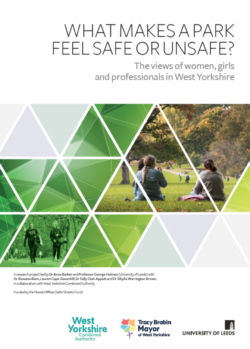 This research report and these posters summarise women, girls and professionals' views on safety in parks. We also produced an addendum to the main report on girls' views on park play spaces and multi-use games areas.
This research report and these posters summarise women, girls and professionals' views on safety in parks. We also produced an addendum to the main report on girls' views on park play spaces and multi-use games areas.
We found that women and girls perceive safety in parks in different ways. Women's views and girls’ views each clustered into three distinct viewpoints. Across these viewpoints, there were areas of consensus and agreement about what shapes perceptions of safety.
We found that professionals hold similar views, despite their different roles. Professionals' views clustered in to two viewpoints, which shared 29 areas of consensus. They diverged in relation to whether the focus should be on addressing structural/cultural factors in society or situational/practical factors in parks that shape perceptions of safety. Overall, we found that professionals' views sit within the range of diverse viewpoints we identified between women and girls. However, professionals were more likely to think that parks are fairly or very safe for women and girls.
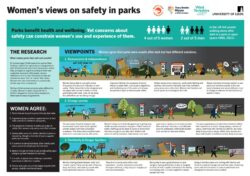
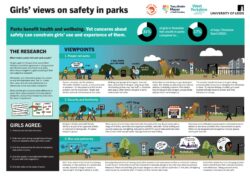
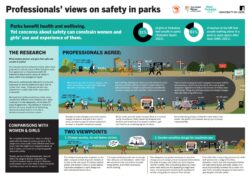
Who did the research?
Dr Anna Barker and Professor George Holmes from the University of Leeds led this project.
The research was conducted with the support of four researchers, including: Dr Sally Osei-Appiah, Dr Sibylla Warrington Brown, Lauren Cape-Davenhill and Dr Rizwana Alam.
We worked with West Yorkshire Combined Authority on this project along with women's centres and youth services in each West Yorkshire district. More information can be found here about the wider Safer Streets Fund project for which the research forms part of: £655,000 secured to improve safety for women and girls - West Yorkshire Combined Authority (westyorks-ca.gov.uk)
The research is part of a wider project aimed at improving the safety of parks in West Yorkshire funded by the Home Office who have made funding available to improve the safety of public spaces for women and girls.
Safer Parks: Improving Access for Women and Girls
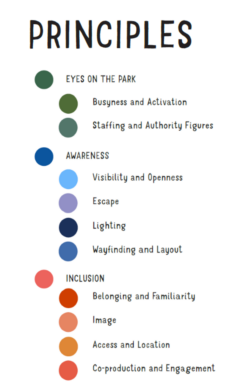
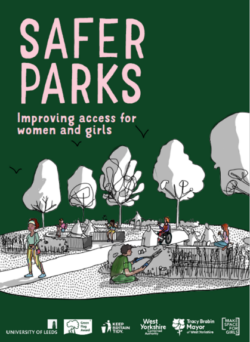
Building on the research findings, Dr Anna Barker and Professor George Holmes have been awarded funding from the ESRC to lead a new collaboration between West Yorkshire Combined Authority, West Yorkshire Police, Keep Britain Tidy, Make Space for Girls, Leeds Women’s Aid, the Vulnerability and Policing Futures Research Centre and the University of Leeds to share and exchange knowledge, evidence and best practices to improve understanding of women and girls' safety in parks and co-produce research-informed parks guidance.
This project co-created new supplementary guidance to the Green Flag Award called 'Safer Parks: Improving Access for Women and Girls'. Better design and management can’t solve all the problems which keep women and girls out of parks, but with the right planning, funding and support, the benefits of parks and green spaces can be enjoyed more equally by everyone.
The guidance was launched by the partnership at the 'Women and Girls' Safety in Parks: Lessons from Research and Practice' international symposium on the 10-11 May 2023. The report of the conference and video presentations are available.
